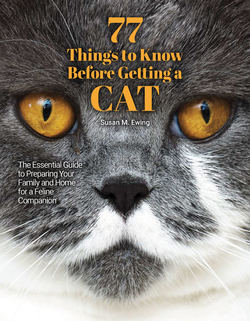Читать книгу 77 Things to Know Before Getting a Cat - Susan Ewing M. - Страница 9
На сайте Литреса книга снята с продажи.
4
What Type of Cat?
ОглавлениеYou have multiple factors to consider when deciding on what type of cat you want. Cats don’t have the size range that you find in dogs. Instead of weighing between 2 and 200 pounds, most cats fall between 4 and 20 pounds (1.8–9.1 kg). Whether you prefer a smaller, more delicate feline, or you have your heart set on a heftier animal, there’s not going to be much difference in how much space either cat needs for comfort.
The Turkish Van’s abundant coat sheds minimally.
Maybe you’re concerned about hair. If a cat has hair, he will shed, but some cats shed less than others. Or you might select a hairless breed, such as the Sphynx or the Devon Rex. The Cornish Rex has a very light, curly coat with minimal shedding, and Russian Blues, LaPerms, Siamese, Tonkinese, and Bengals also shed minimally. According to CatTime (www.cattime.com), even the longhaired Turkish Van is a light shedder, so, if you want a cat with a longer coat but are worried about shedding, the Turkish Van might be a good choice.
If you do choose a hairless or sparsely coated breed, remember that your cat will need protection from the cold, which may mean a sweater or coat if you live where there are cold winters. All cats must have shelter, but hairless breeds will do best living entirely indoors.
You shouldn’t base your choice solely on whether or not the cat sheds, though. Consider the personality of the breed and the individual cat. Bengals, for instance, are high-energy cats that need exercise. Ragdolls are at the other extreme—perfectly happy to lie quietly and be admired. If you’re selecting a pedigreed cat, do some research about what it’s like to live with a particular breed. In the larger scheme of things, I’d rather have a cat whose personality was a good fit even if it meant more hair on the furniture, but that’s something you need to decide before you get a cat.
The Sphynx is a hairless cat breed.
Another consideration is whether to get a male or female. There will be exceptions, but cat owners generally agree that males are more affectionate than females. Affection doesn’t matter if a cat lives in a barn as a mouser, but most people who have pet cats prefer their cats to show some affection.
The striking Siamese is a popular breed.
In their book, Your Ideal Cat: Insights into Breed and Gender Differences in Cat Behavior, authors Benjamin L. Hart, DVM, PhD, and Lynette A. Hart, PhD, rank some cat breeds according to how affectionate they are. The Ragdoll scored the highest, followed by the domestic shorthair, Burmese, and Maine Coon. Least likely to show affection were the Bengal, Manx, and Abyssinian. Still, many owners of cat breeds that aren’t known for showing affection will argue that their cats are affectionate. Members of the Cat Writers’ Association to whom I spoke were all in agreement that a cat’s affectionate and outgoing temperament is the result of both genetics and living environment. It partially depends on how much, and what kind of, affection you expect from your cat.
Teresa Keiger, editor of Cat Talk magazine, notes that some breeds are more gregarious than others, and some are more cautious around strangers. “Russian Blues are [more cautious]. They also bond closely with their owners . . . and are a classic example of what breeding to improve temperament can achieve. Breeding for temperament changed their demeanor.”
Keiger discusses another factor that influences an individual cat’s personality. “The usual ‘pecking order’ is whole females, whole males, spays, neuters. Genetics plays a huge role in temperament, and breeders take that into consideration in their breeding programs. I would not be surprised to learn that sensory input played a role in temperament.” She also says, “Another factor is exposure to various and frequent stimuli from an early age. Kittens exposed to a higher level of noise and activity generally seem to be less shy than ones raised in a quiet environment. So, it’s nature and nurture.”
While Bev Caldwell, retired feline health and behavior writer and longtime owner of pedigreed cats, agrees that males are generally more affectionate, she adds that it also depends on the individual cat and probably whether the owner has had the cat from kittenhood or has adopted an adult cat. Sometimes adult shelter cats may come with bad habits or may have temperaments shaped by previous mistreatment, such as being removed from their mothers too early or being neglected by former owners.
Russian Blue kitten.
Being regarded as more affectionate gives males an edge over females, but, on the negative side, males are much more likely than females to spray their urine. It’s a way of marking their territory. Neutering helps, but may not totally extinguish, spraying behavior.
SAY WHAT?
Some breeds are more talkative than others. For example, the Siamese is noted for carrying on almost continual conversations. Some people find this charming; others may find it annoying.
Regardless of breed and sex, all cats will have their good and bad points. It’s a good idea to research breeds and to consider what traits you can and can’t live with. In the end, though, you may have decided on a shorthaired male Siamese only to be captivated by a female domestic longhair. Do your homework—but it’s also OK to listen to your heart.
AFFECTION MATTERS
Take into account both the breed and the sex, but don’t ignore the power of affection and attention as it relates to your cat’s temperament.
How affectionate a cat is varies by breed and individual.
